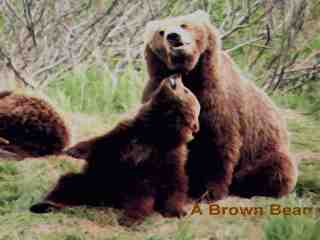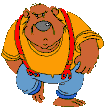:CONTENTS:

Brown
Bear's

The brown bear (Ursus arctos) has the widest distribution
of all bears in the world. Its range includes much of the Northern
Hemisphere, from the edges of the arctic seas of North America, Europe,
and Asia, south over tundra covered mountains, across the boreal forests
of Canada and the Soviet Union, down as far as Mexico, Spain, and Iran.
On both continents, the southern edges of its range are marked widely scattered,
isolated populations. Although brown bears may be found in a variety
of habits, they generally prefer regions punctuated by river valleys, mountain
forests, and pen meadows.
The
Brown Bear's Body
the brown bear is stout and rather chunky in shape, with a large
hump of fat and muscle over the shoulders and very long claws. It
has a wide, massive head that some people describe as being somewhat ‘dish
faced" in appearance. That big head is equipped with extremely powerful
jaws. I once saw a big male, trapped in a leg snare set by researchers,
take out its frustration on some neighboring trees.
Brown
Bear food Strategies
Practically anything edible is grist to the brown bear's meal.
To fuel such a large body, the bears must consume a lot of calories up
to 80 or 90 pounds (36 to 41 kg) of food a day during the peak of the season.
By eating this much food, a big bear can gain from 3 to 6 pounds (1.25
to 2.75 kg) of fat in a 24 hour period. Physiologically, they are
driven to gain at this rapid rate, because the time of summer abundance
is very short and the winters long.
Brown
Bear Hibernation
In all parts of their range, except perhaps in eastern turkey
and Iran, brown bears spend the winter months hibernating in dens.
At the beginning of the denning season, they may have 6 to 10 inches (15
to 25 cm) of fat under their skin. Den sites are usually remote,
isolated from human activity and development. Noise from machinery
and aircraft is disturbing and may force some bears to avoid the
area for future denning. In the soviet Union, brown bears that have
not found a denning site are considered particularly dangerous.
Rock caves and hollows excavated under large trees or dug
horizontally into hillsides are the commonest types of dens. Often
they contain a short tunnel leading to the sleeping chamber. Depending
upon the size of the bear, a sleeping chamber can measure over 7 feet wide
and 3 feet high (2 m by 1 m). Some dens have been used for century
by numerous generations of bears.
In the more northern parts of their range, brown bears
will sometimes den as early as the middle of September. Farther south,
denning may be as late as October or November. When he bears emerge
in April or may, they head for the nearest place where they might expect
to find food.
Other
Types of Brown Bear:
The
Giant bears of Kamchatka
The rugged Kamchatka Peninsula is a great finger of land jutting
south from eastern Russia into the sea of north of Japan. The
majority of Kamchatka bears are relatively small animals, comparable to
those of northern Europe. But native legends tell of a giant race
of black colored bears, some of which weigh more than 2,500 pounds (1,134
kg.). The first scientific evidence that brown bear this size might
really exist was presented during the 1950’s in a report about the investigations
of Dr. Stan Bergman of the State Museum of Natural History at Stockholm,
who spent two years on the Kamchatka Peninsula. Apparently the bears were
either hard to approach or very scarce because Dr. Bergman never saw a
living specimen. He was, however, able to photograph a bear's footprint
in the snow. It left a track 15 inches (38 cm) long and 10 inches (25 cm)
wide. Based on his measurements, this bear would have been much bigger
than the largest known Kodiak bears living just across the Bearing Strait.
Asian
Bears:
In the northern mountains of India and in other parts of the
Himalayas lives a reddish colored brown bear very similar to the American
grizzly. Called the red bear (Ursus arctos isabelinus) by the people
of the region, it is about the size of a large grizzly, ranging from 5.5
to 8 feet (1.7 to 2.5 cm) in length.
Other races of asian brown bears include the little known
Manchurian brown bear (Ursus arctos manchuricus) and the so-called horse
bear (Ursus arctos pruinosus) of Tibet, Sichuan, and other western
province of China. This bear is often bicolored, with yellow brown
or whitish cape forming a saddle shaped marking across its shoulders.
Horse bears are very much feared in the regions where they are found.
Higuma,
The Brown Bear of Japan
The brown bears are found only on Hokkaido, Japan's northernmost
island. But this island of a little more than 30,000 square miles
(77,000 sq. km) has nearly four times the brown bear population of the
entire continental United States!


